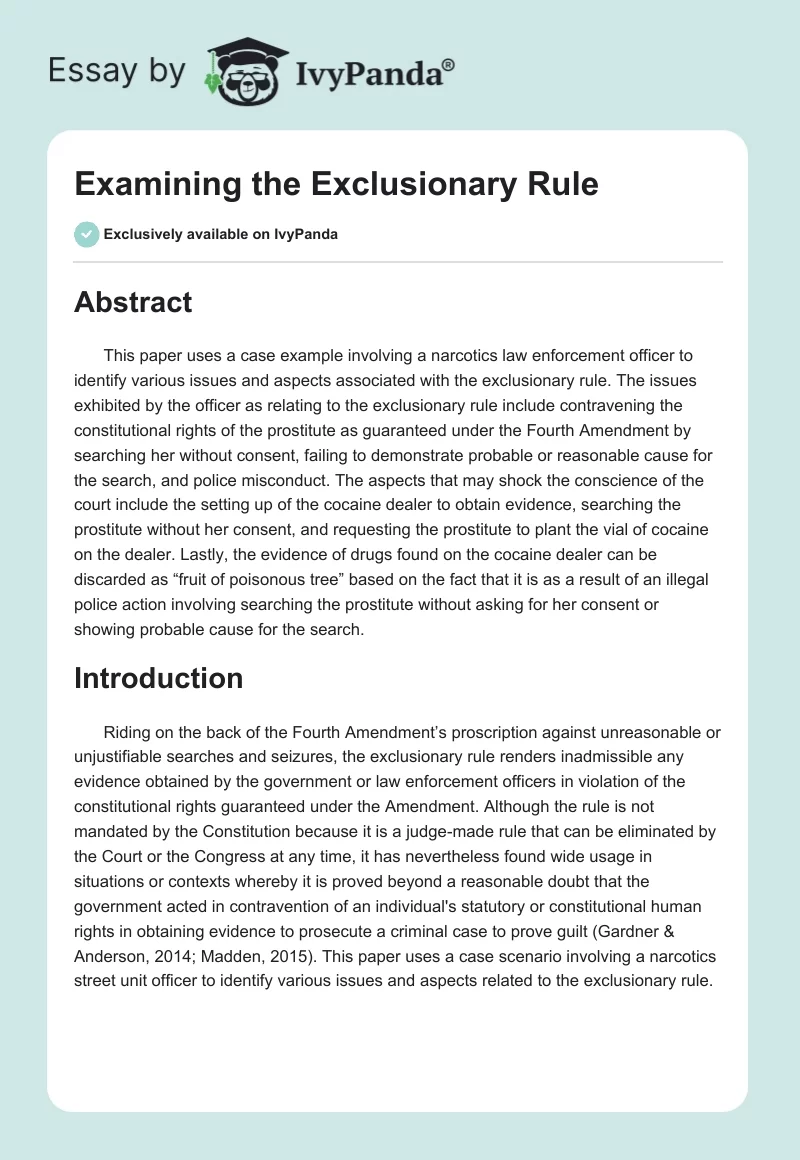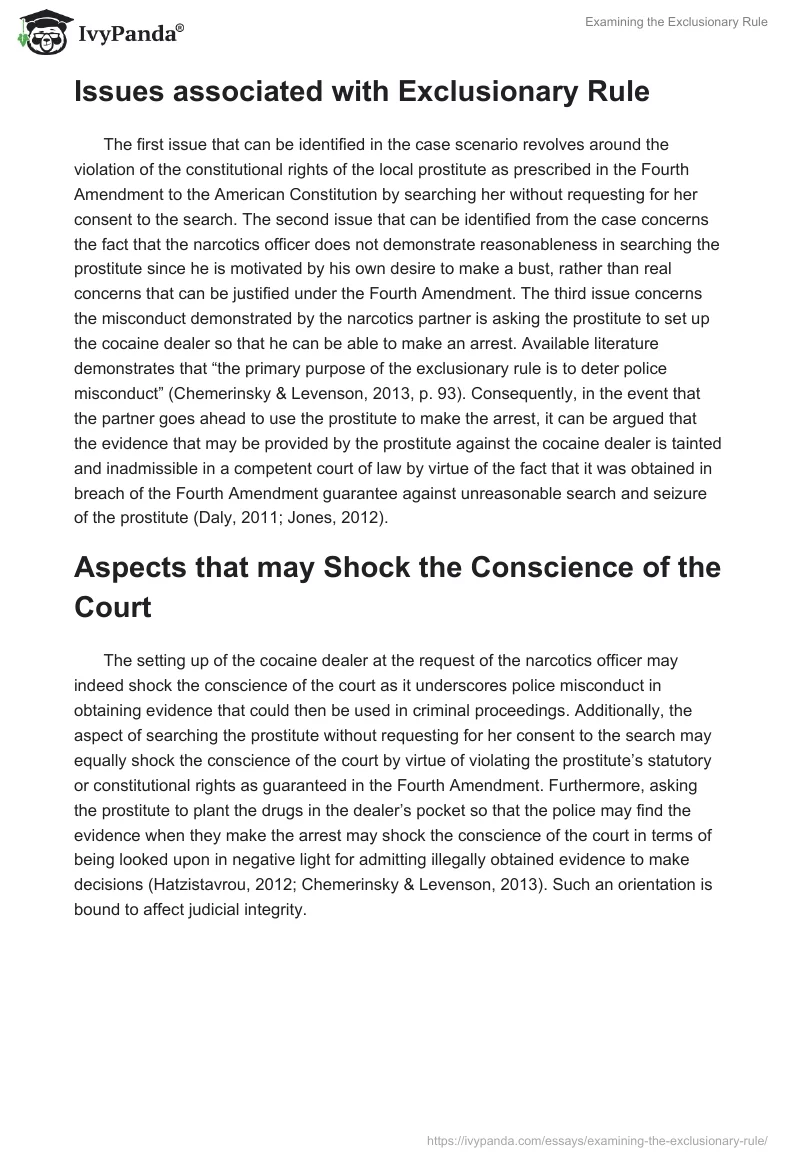Abstract
This paper uses a case example involving a narcotics law enforcement officer to identify various issues and aspects associated with the exclusionary rule. The issues exhibited by the officer as relating to the exclusionary rule include contravening the constitutional rights of the prostitute as guaranteed under the Fourth Amendment by searching her without consent, failing to demonstrate probable or reasonable cause for the search, and police misconduct. The aspects that may shock the conscience of the court include the setting up of the cocaine dealer to obtain evidence, searching the prostitute without her consent, and requesting the prostitute to plant the vial of cocaine on the dealer. Lastly, the evidence of drugs found on the cocaine dealer can be discarded as “fruit of poisonous tree” based on the fact that it is as a result of an illegal police action involving searching the prostitute without asking for her consent or showing probable cause for the search.
Introduction
Riding on the back of the Fourth Amendment’s proscription against unreasonable or unjustifiable searches and seizures, the exclusionary rule renders inadmissible any evidence obtained by the government or law enforcement officers in violation of the constitutional rights guaranteed under the Amendment. Although the rule is not mandated by the Constitution because it is a judge-made rule that can be eliminated by the Court or the Congress at any time, it has nevertheless found wide usage in situations or contexts whereby it is proved beyond a reasonable doubt that the government acted in contravention of an individual’s statutory or constitutional human rights in obtaining evidence to prosecute a criminal case to prove guilt (Gardner & Anderson, 2014; Madden, 2015). This paper uses a case scenario involving a narcotics street unit officer to identify various issues and aspects related to the exclusionary rule.
Issues associated with Exclusionary Rule
The first issue that can be identified in the case scenario revolves around the violation of the constitutional rights of the local prostitute as prescribed in the Fourth Amendment to the American Constitution by searching her without requesting for her consent to the search. The second issue that can be identified from the case concerns the fact that the narcotics officer does not demonstrate reasonableness in searching the prostitute since he is motivated by his own desire to make a bust, rather than real concerns that can be justified under the Fourth Amendment. The third issue concerns the misconduct demonstrated by the narcotics partner is asking the prostitute to set up the cocaine dealer so that he can be able to make an arrest. Available literature demonstrates that “the primary purpose of the exclusionary rule is to deter police misconduct” (Chemerinsky & Levenson, 2013, p. 93). Consequently, in the event that the partner goes ahead to use the prostitute to make the arrest, it can be argued that the evidence that may be provided by the prostitute against the cocaine dealer is tainted and inadmissible in a competent court of law by virtue of the fact that it was obtained in breach of the Fourth Amendment guarantee against unreasonable search and seizure of the prostitute (Daly, 2011; Jones, 2012).
Aspects that may Shock the Conscience of the Court
The setting up of the cocaine dealer at the request of the narcotics officer may indeed shock the conscience of the court as it underscores police misconduct in obtaining evidence that could then be used in criminal proceedings. Additionally, the aspect of searching the prostitute without requesting for her consent to the search may equally shock the conscience of the court by virtue of violating the prostitute’s statutory or constitutional rights as guaranteed in the Fourth Amendment. Furthermore, asking the prostitute to plant the drugs in the dealer’s pocket so that the police may find the evidence when they make the arrest may shock the conscience of the court in terms of being looked upon in negative light for admitting illegally obtained evidence to make decisions (Hatzistavrou, 2012; Chemerinsky & Levenson, 2013). Such an orientation is bound to affect judicial integrity.
Evidence Discarded as “Fruit of the Poisonous Tree”
The “fruit of the poisonous tree” doctrine, according to Chemerinsky and Levenson (2013), “states that once the primary evidence (the tree) is shown to have been unlawfully obtained, any secondary evidence (the fruit) derived from it is also inadmissible” (p. 101). Based on this elucidation, it is clear that the evidence relating to the cocaine dealer may be discarded by a competent court of law as “fruit of the poisonous tree” based on the fact that the initial evidence of cocaine found on the prostitute was as a result of an illegal police action entailing searching the prostitute without a warrant or reasonable cause.
Conclusion
The present paper has used a case scenario involving a narcotics officer to identify various issues and aspects related to the exclusionary rule. The issues exhibited by the partner as relating to the exclusionary rule include violating the constitutional rights of the prostitute by searching her without requesting for her consent, failing to show probable cause for the search, and police misconduct. The aspects that may shock the conscience of the court in this case scenario include the setting up of the cocaine dealer to obtain evidence, searching the prostitute without her consent, as well as asking the prostitute to plant the vial of cocaine on the dealer in a blatant attempt to undermine judicial integrity. Lastly, the evidence of cocaine found on the dealer can be discarded as “fruit of poisonous tree” based on the fact that it is a result of an illegal action that is closely associated with police misconduct.
References
Chemerinsky, E., & Levenson, L.L. (2013). Criminal procedure: Investigation. Alphen aan den Rign, Netherlands: Aspen Publishers.
Daly, Y.M. (2011). Exclusion of evidence: DPP (Walsh) v Cash. International Journal of Evidence & Proof, 15(1), 62-69. Web.
Gardner, T.J., & Anderson, T.M. (2014). Criminal law (12th ed.). Belmont, CA: Wadsworth Publishing.
Hatzistavrou, A. (2012). Motivation, reconsideration and exclusionary reasons. Ratio Juris, 25, 318-342. Web.
Jones, D.M. (2012). Hudson v. Michigan and the decline of the exclusionary rule. Police Practice & Research, 13, 282-293. Web.
Madden, M. (2015). A model for excluding improperly or unconstitutionally obtained evidence. Berkeley Journal of International Law, 33, 442-488. Web.


